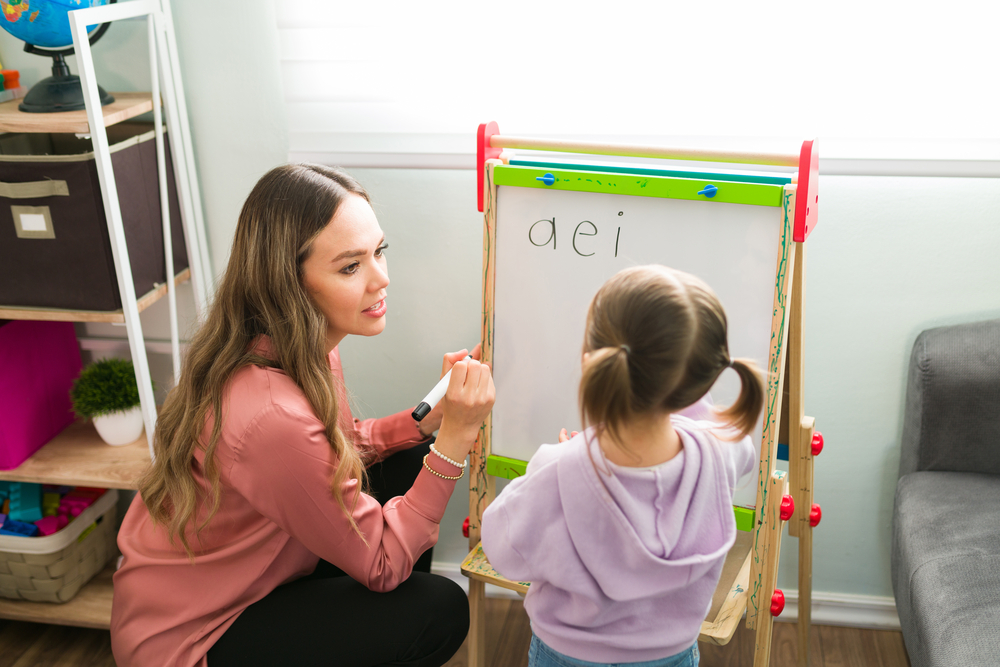Ooey, gooey, sticky, squishy, smooth, fun stuff! Whether you’re mixing up colorful bags of shaving cream, playing a sensory treasure hunt game, or bulldozing beans and flour, sensory activities for toddlers are a great way to introduce kids to the wonderful world of texture.
Looking for a place to start? We’ve put together this list of 5 great toddler sensory activities you can do at home.
The Short Cut
- Sensory activities help toddlers maintain their Curiosity, one of the 5 C’s at the heart of the Begin Approach to helping kids thrive in school and life
- Sensory play also engages kids’ senses and encourages them to move their bodies, a Core Skill that helps their brains develop
- Many sensory activities for toddlers can be created with things from the home—it’s easy and fun!
- Developing the 5 C’s doesn’t need to be complicated. You can make a big difference in only 15 minutes a day!
What Is Sensory Play and Why Is It Important?
Sensory play is any activity that engages a child’s five senses: sight, hearing, touch, taste, and smell. Experts also consider play that helps kids develop their balance (specifically the vestibular system that helps them know what their heads are doing) and sense of where their bodies are (called proprioception) sensory as well.
Whether it comes through DIY activities or everyday playtime, here are some of the many benefits of sensory play for toddlers:
- Using their senses helps toddlers’ brains make new connections, literally shaping how their minds engage with the world
- As you describe what your child is touching, hearing, smelling, seeing, or tasting, it helps build important vocabulary, including their ability to describe colors
- Fun sensory activities for toddlers also offer chances for social interaction, which helps them build Character, another of the 5 C’s
- Many sensory activities (like searching through beans for a toy) involve problem-solving and gross or fine motor skills, helping develop Critical Thinking and Core Skills
5 Sensory Activities for Toddlers
Sensory Ocean Zen Garden
This zen garden is a great way to give your child something fun to do outdoors on a nice afternoon—and like many sensory activities, it can help an overstimulated toddler calm down!
What You’ll Need
- Bag of stale cereal
- Baking pan or play bin
- Shells, stones, and ocean animal toys
- A fork
What to Do
- Use a blender to grind stale cereal pieces up to make the “sand” base
- Pour the “sand” into your pan or bin, then spread it out until it forms a smooth surface
- Add shells, pebbles, and ocean animal toys
- Give your child a fork or a shell and demonstrate how to make strokes and patterns in the sand. It might calm your senses down too!
Ocean Sensory Bin
Take dried pasta, then add ocean toys and water, and you can create a fun sensory bin for toddlers to explore!
What You’ll Need
- Medium-sized bin or deep tray
- Dried pastas for coral
- Child-safe, nontoxic paint
- Play dough
- Water
- Blue food coloring (optional)
- Scoops or cups for playing in the water
- Ocean creature toys and loose parts like pebbles, shells, starfish
What to Do
1. Put one cup of dried pasta into a resealable plastic bag or container, then squirt paint in until the pasta is covered. The pasta will represent coral, so use vibrant colors like pink, purple, and green.
2. Seal the container or plastic bag, then shake it up so the pasta becomes covered in paint. Take the painted pasta out and lay it on a baking tray to dry.
3. Shape the play dough into small “rocks,” then add it to the bin. Press the pasta into the play dough and presto! Your “coral” is complete.
4. Now that you’ve made your reef, it’s time to put it under the sea! Add water to the bin until the coral is partly covered (leaving some exposed creates more play surfaces). You can add blue food coloring to make it look a little more like the ocean if you want.
5. Set your water and ocean animal toys out next to the bin for the kids to play with. Now they’re ready to explore the ocean world!
Play Tips: You can use this activity to encourage problem-solving. Many times something your child wants to do, like placing a turtle on the reef, won’t work the first time. Encourage them to try different approaches until they find one that works. This mimics the scientific method of observing, forming a hypothesis, experimenting, and drawing conclusions.
Color Mixing Sensory Bag
What do you get when you mix two colors? A third color! Exploring how this works invites your child to name colors and discover how they relate to each other.
What You’ll Need
- Icing or shaving cream
- Food coloring
- Two small bowls
- Toothpick or spatula
- Large zip-top bag and tape or cookie sheet (the cookie sheet option lets kids get their hands on the activity a little more, but the bag creates less mess)
What to Do
- Put about a cup of shaving cream or icing into two small bowls.
- Pick two colors of food coloring to mix.
- Add a drop or two of color into each bowl, keeping the colors separate.
- Let your child mix the colors into the shaving cream or icing with their hands, the toothpick, or the spatula until they’re well blended.
- Tape the bag to a working surface or lay out the cookie sheet.
- Close the bag, then let your child mix the colors by squishing and smushing the bag until the colors are blended.
- Scoop some of each color into the bag or onto the cookie sheet, then let your child smush them together until they make a new color.
Play Tips
- Encourage your child to experiment with the different tools you got out. The toothpick has very different results than the spatula!
- If you use food coloring and icing, you can make this part of an afternoon of baking by spooning the colored icing onto cookies when you’re done!
2 Ingredient “Sandy” Sensory Bin
A little flour and oil can bring beach exploration home for your toddler!
What You’ll Need
- 6 cups flour
- 1 cup oil (vegetable, canola, or baby oil work well)
- Ocean objects of your choosing! Try pasta shells, plastic fish and sea creatures, or textured rocks
- Plastic bin or cardboard box
- Old toothbrush (optional)
What to Do
- Mix 6 cups of flour and 1 cup of oil in a bowl to create the sand. Using a fork, press the oil into the flour and mix until the texture becomes sandy. Some toddlers enjoy helping with this step, or you can do it yourself ahead of time.
- Transfer the sand into the bin or box.
- Press objects into the sand to bury them (or pour sand over the top), then encourage your child to sift through the sand to find them and see how it feels as they search!
NOTE: This activity can get messy, so play it outside or on an easy-to-clean surface.
Play Tips
- After you’ve hidden your objects, encourage your child to describe them as they find them and group them into categories (all the green ones, all the animals, etc.)
- Pretend you’re at the beach! Wear bathing suits, spread out a towel or blanket, and get out your favorite beach toys like toddler-sized shovels and rakes.
- Make it a good-natured race! Hide the items, then invite a sibling, friend, or grown-up to play along. Who can find them the fastest?
Dump Truck Sensory Bin Activity
Samantha Creighan, Begin’s Vice President of Curriculum Design, created this activity for us several years ago, when her son was 2 years old and obsessed with construction vehicles. It took advantage of his natural interest in vehicles (a great way to encourage Curiosity!), and it goes great with the “Dump Truck” story in our HOMER app!
What You’ll Need
- 3 disposable cookie sheets
- Flour
- Decaffeinated coffee grounds
- Dried beans
- Construction toys
- Shovels, cups, or small buckets
- Spray bottle filled with water (optional)
- Sifter (optional)
- Rocks, leaves, and sticks (optional)
What to Do
- Set the cookie sheets outside or in a play area that’s easy to clean.
- Fill 1 cookie sheet each with flour, decaffeinated coffee grounds, and dried beans.
- Lay out the construction toys, shovels and cups, and spray bottle near the trays so they’re ready to play with.
- Invite your child to play construction site! The toys can push the materials around, roll through them, get stuck and unstuck, and more. And the shovels and cups can help make mounds to dig through or roll up.
Play Tips
- To extend play, use the sifter to get the different materials wet, and see if your child can figure out how to use the resulting changes in their construction projects
- Add rocks, sticks, and leaves to the trays and encourage your child to see how they affect the vehicles and how they can be used (to make trees, structures, etc.)
- Try the same activity with other kinds of toys—your child could make a dinosaur world, a fairy tale wonderland, a zoo, or anything else they’re excited about!
There’s So Much Out There to Enjoy
We love sensory activities for toddlers because they’re so good for them in so many ways—encouraging Curiosity, building Critical Thinking skills, helping develop Character, and more. Plus they reach kids through the power of play, the most natural way for them to learn.
There are a ton of great ways to help toddlers thrive—from kid-safe apps that develop Core Skills and Character to Curiosity-building at-home activity kits delivered right to your door. Check out our Early Learner Bundle to see all the ways we can give your child their best start to achieving their fullest potential.













